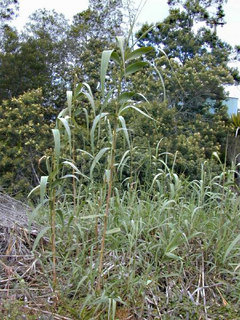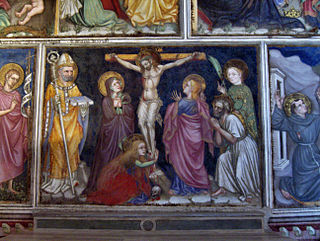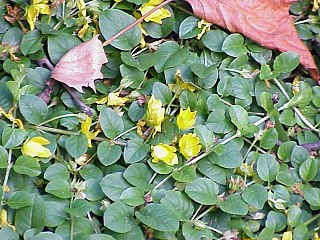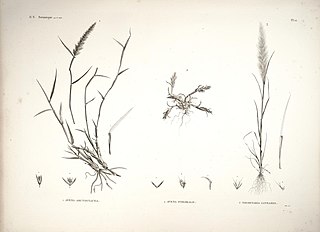
Arundo is a genus of stout, perennial plants in the grass family.

Jacopo De Fazio, best known as the blessed Jacobus de Varagine, or in Latin Voragine was an Italian chronicler and archbishop of Genoa. He was the author, or more accurately the compiler, of Legenda Aurea, the Golden Legend, a collection of the legendary lives of the greater saints of the medieval church that was one of the most popular religious works of the Middle Ages.

The Golden Legend is a collection of hagiographies by Jacobus de Varagine that was widely read in late medieval Europe. More than a thousand manuscripts of the text have survived. It was likely compiled around the years 1259–1266, although the text was added to over the centuries.

Saint Giles, also known as Giles the Hermit, was a hermit or monk active in the lower Rhône most likely in the 6th century. Revered as a saint, his cult became widely diffused but his hagiography is mostly legendary. A town that bears his name grew up around the monastery he purportedly founded, which became a pilgrimage centre and a stop on the Way of Saint James. He is traditionally one of the Fourteen Holy Helpers.

The Lei Áurea, adopted on May 13, 1888, was the law that abolished slavery in Brazil. It was signed by Isabel, Princess Imperial of Brazil (1846–1921), an opponent of slavery, who acted as regent to Emperor Pedro II, who was in Europe.

Monica was an early North African Christian saint and the mother of Augustine of Hippo. She is remembered and honored in the Catholic and Orthodox Churches, albeit on different feast days, for her outstanding Christian virtues, particularly the suffering caused by her husband's adultery, and her prayerful life dedicated to the reformation of her son, who wrote extensively of her pious acts and life with her in his Confessions. Popular Christian legends recall Monica weeping every night for her son Augustine.

Lamarckia is a Eurasian and African plant in the grass family.

Lysimachia nummularia is a species of flowering plant in the primrose family Primulaceae. Its common names include moneywort, creeping jenny, herb twopence and twopenny grass.

Rostraria is a genus of plants in the grass family, native primarily to Eurasia and North Africa with one species native to South America. Hairgrass is a common name.
A legendary is a collection of saints' lives. The word derives from the Latin word legenda, meaning 'things to be read'. The first legendaries were manuscripts written in the Middle Ages, including collections such as the South English legendaries or the Golden Legend.

Trisetaria is a genus of plants in the grass family, native to Asia and to the Mediterranean region.

The Field Elm cultivar Ulmus minor 'Dicksonii', commonly known as Dickson's Golden Elm, is a yellow-leaved tree raised in Chester in 1900 by Dickson's Nursery, which distributed it from the autumn of 1907 as 'Golden Cornish Elm'. 'Cornish Elm' was the name often given in error to Guernsey or Wheatley Elm by the local authorities who planted the latter extensively, an error which may have influenced the choice of name by Dickson's nursery. 'Dicksonii' is usually listed as a variety of Guernsey Elm rather than Cornish Elm, Bean giving 'Wheatleyi Aurea' as a synonym, and Hillier 'Sarniensis Aurea' and later U. × sarniensis 'Dicksonii'. Clibrans' nursery of Altrincham, however, described it (1922) as otherwise identical "in habit and constitution" to 'type' Cornish Elm. The Späth nursery of Berlin distributed it from c.1913 as U. campestris cornubiensis Dicksonii. The nursery Messieurs Otin père et fils of Saint-Étienne sold an Ulmus Wheatleyi aurea pyramidalis, with leaves marbled yellow, in 1882, earlier than Dickson's introduction.
Catapodium marinum is a species of annual herb in the family Poaceae. They have a self-supporting growth form and simple, broad leaves. Individuals can grow to 22 cm tall.
Catapodium rigidum (Ferngrass) is a species of annual grass in the family Poaceae. They have a self-supporting growth form and simple, broad leaves and dry fruit. Individuals can grow to 20 cm tall.
Thinopyrum junceum is a species of perennial herb in the family Poaceae. They have a self-supporting growth form and simple, broad leaves. Individuals can grow to 52 cm tall.

Matricaria aurea is a species of plants in the family Asteraceae.
Parapholis marginata is a species of grass in the family Poaceae.
Piptatherum coerulescens is a species of perennial grass in the family Poaceae. They have a self-supporting growth form.

Polypogon viridis is a species of perennial grass in the family Poaceae. They have a self-supporting growth form and simple, broad leaves. Individuals can grow to 0.43 m.
Sphenopus divaricatus is a species of grass in the family Poaceae.












